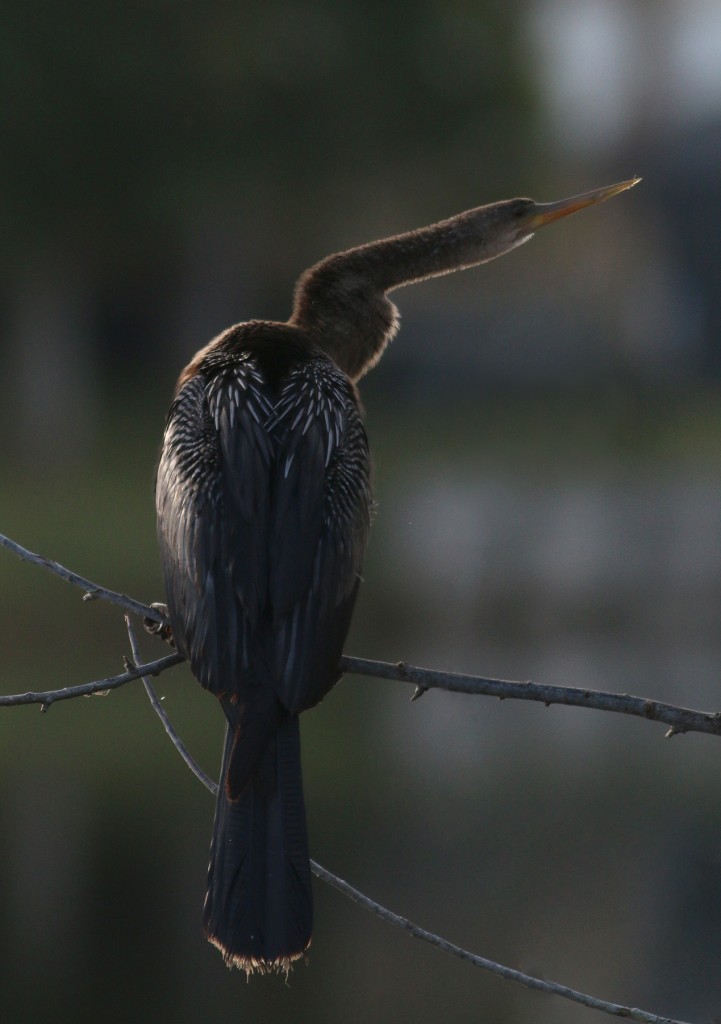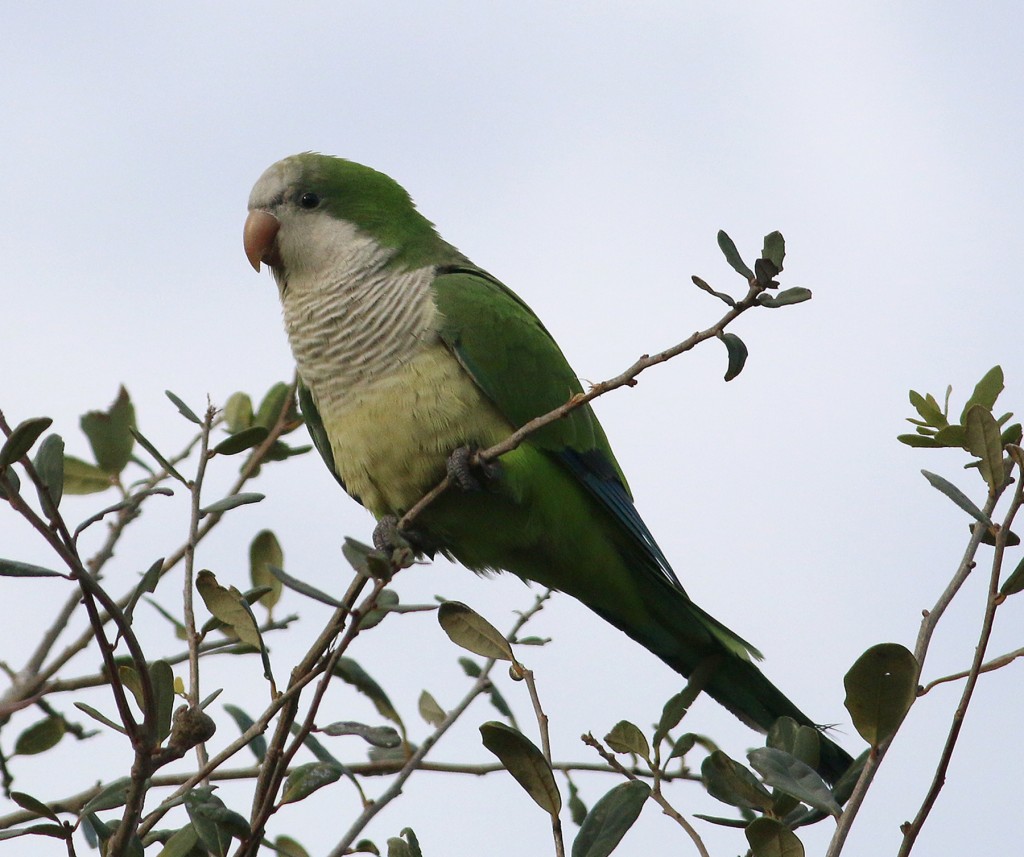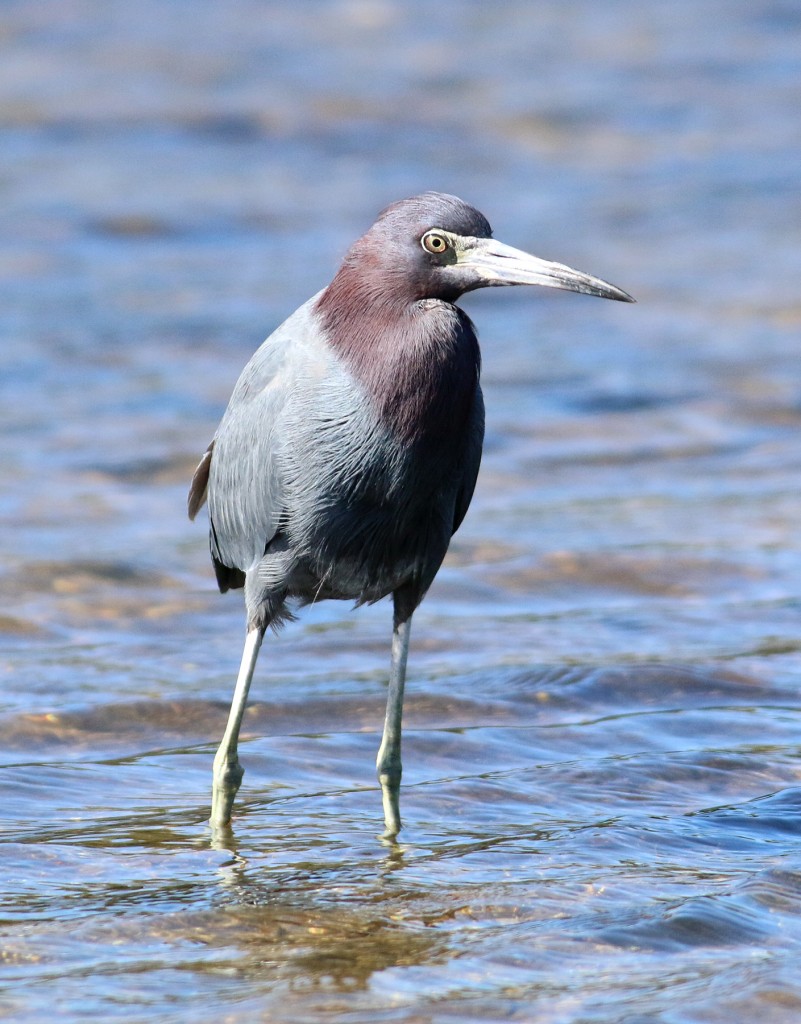We tend to take our local patches and our common birds for granted. One of the pleasures of birding while traveling though is that we get the opportunity to experience the common birds of another location that might be difficult to see in our own patch. This happened to me this morning as I was birding a small community park. Actually it was more of a recreation complex, consisting mostly of tennis courts and ball fields, but bordered by a small waterway and scrub area along a power line cut. It’s not a destination that traveling birders flock to. Few people outside of the neighborhood or the county visit here. But it struck me how the birds that we saw in a mere 30 minutes with very little effort can be seen here nearly every day of the week, yet they would have filled the rare bird alerts back in New Jersey. Imagine a day in NJ with Anhingha, Loggerhead Shrike, Common Gallinule, Wood Stork, Sandhill Crane, Eurasian Collared-Dove, Nanday Parakeet, Monk Parakeet, Red-shouldered Hawk, and Tricolored Heron. But here in this simple local patch in Florida its just another day. Here’s a few photos from this morning’s walk:
I am a big fan of surprises in birding. Usually the best surprises are seeing unexpected birds…rarities or out-of-season birds. Today involved a surprise of a different kind. In preparation for this month-long trip to Florida I did a bit of pre-trip investigation, looking up the birding hotspots and trying to get an idea of the species expected to be seen at those locations during this time of year. Today, while roaming around the neighborhood by bike here in Florida, I spotted a break in the mangroves with a Reddish Egret hunting in the shallow lagoon. Great. When I parked the bike, the surprises kept coming. A Roseate Spoonbill. Fly-by Wood Storks. More Roseate Spoonbills. A few Tri-colored Herons. I sat down on the bank with my camera, and then 20 or so White Ibis appeared from out of nowhere. Little Blue Herons approached almost too close to focus. From that one unnamed spot I had a total of nine species of waders within 50 yards (and usually much closer) behaving as if I wasn’t there, plus flyover Glossy Ibis, making it a 10-wader stop. All unexpected. I love surprises when birding.

A Reddish Egret in its hunting pose. It chases its prey, often with wings raised, unlike more stationary hunters like Great Egret.
Its springtime here in the northeast, and the migrants are coming through and filling the air with song, bringing us to today’s topic. When searching for birds, most beginning birders focus on the ‘watching’ part of birdwatching; looking for bright colors and trying to spot movements that reveal the presence of a bird. That is a very reasonable place to begin, but perhaps the main difference between novice and experienced birders is that skilled birders are much more attuned to finding birds by using their ears. We birders are fortunate that birds often make sounds that reveal their presence, unlike animals like deer, reptiles, butterflies, etc. that typically remain silent to avoid detection. This is incredibly valuable because even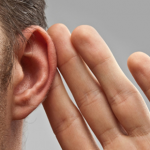 the most colorful birds can be very difficult to find when they are not moving. Bird sounds can range from full-scale songs intended to advertise territory or to attract a mate, to contact calls for communicating with their partners or other members of their flock, to warning calls signaling that danger is near, to begging calls from juveniles to their parents. Many of these sounds are distinct for a particular species and can even be used to distinguish species that are outwardly very similar.
the most colorful birds can be very difficult to find when they are not moving. Bird sounds can range from full-scale songs intended to advertise territory or to attract a mate, to contact calls for communicating with their partners or other members of their flock, to warning calls signaling that danger is near, to begging calls from juveniles to their parents. Many of these sounds are distinct for a particular species and can even be used to distinguish species that are outwardly very similar.
It is intuitive that using the two senses of sight and hearing to finds birds will result in greater success than using only one of them, but it is perhaps not so obvious that birding by ear often is actually more productive than using vision. This is due to the fact that we can hear all around us while our vision is restricted to just a portion of the view in front, so birding by ear enables detection of birds in all directions. Moreover, sounds travel around obstacles, so a bird that is obscured by a leaf or a branch might not be visible, but can still be heard. Thus, under the most difficult viewing conditions, such as when birds are singing from within thick foliage, or from the dense reeds of a marsh, or even at night when we can’t see them at all, they can still be identified if they are vocalizing. As a gauge of its importance, I estimate that when I am birding for spring migrants, perhaps 70% of the birds are located and identified first by sound, and only subsequently by sight. That means that if you are only birding by sight, then you are missing well more than half of the birds in the area.
Assuming that you now are convinced that birding by ear is a useful skill that can bring your birding to a new level, how then do we go about developing that skill? I pass along two suggestions that I found helpful. First of all, birding by ear is a skill that does not just happen because we want it to happen. It is something that we need to develop actively. Although it is theoretically possible to download recordings of bird songs and attempt to memorize them one by one, in practice this is not a realistic goal. Most of us simply do not have the ear to distinguish and memorize hundreds of songs without first learning HOW to do it. Fortunately, instructional series exist that teach the songs of many bird species, and it is well worth the investment to 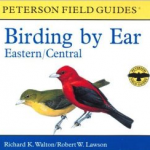 acquire these lessons. I highly recommend the Peterson Field Guides Birding By Ear and More Birding By Ear discs. These lessons teach bird song brilliantly using a few simple techniques. First, the bird songs are placed into logical groups (Warblers with simple songs, Warblers with complex songs, Thrushes, Vireos, Woodpeckers, etc.) that typically consist of four to seven species, thereby simplifying the process. Thus, even if we can’t at first identify the species, at least we can narrow it down to a small group of possibilities. Second, within the groups, the songs are repeated and compared to each other, stimulating the learning process. Finally, the methods used in these lessons train us to listen to the structure of the song, its length, its volume, and its tone. The same methods can be used to analyze the songs of any new species that might be heard. For example, if I travel to a foreign country and hear a song for the first time, I immediately take note of whether the song consists of simple repeated notes or has a more complex structure, whether the song changes in volume or pitch, and whether it has multiple parts. Similar to the way we learn key identification points when birding visually, these lessons teach the audible clues that are diagnostic for common bird species.
acquire these lessons. I highly recommend the Peterson Field Guides Birding By Ear and More Birding By Ear discs. These lessons teach bird song brilliantly using a few simple techniques. First, the bird songs are placed into logical groups (Warblers with simple songs, Warblers with complex songs, Thrushes, Vireos, Woodpeckers, etc.) that typically consist of four to seven species, thereby simplifying the process. Thus, even if we can’t at first identify the species, at least we can narrow it down to a small group of possibilities. Second, within the groups, the songs are repeated and compared to each other, stimulating the learning process. Finally, the methods used in these lessons train us to listen to the structure of the song, its length, its volume, and its tone. The same methods can be used to analyze the songs of any new species that might be heard. For example, if I travel to a foreign country and hear a song for the first time, I immediately take note of whether the song consists of simple repeated notes or has a more complex structure, whether the song changes in volume or pitch, and whether it has multiple parts. Similar to the way we learn key identification points when birding visually, these lessons teach the audible clues that are diagnostic for common bird species.
Learning all the bird songs, however, is only part of the story. A second step is to develop techniques that make it possible to hear and register as many sounds as possible. Of utmost importance, birding ideally should be done quietly to enable hearing weak, high-pitched, or distant sounds. But even moreso, we need to train ourselves to immediately connect that sound with the correct species. I have found it an extremely helpful exercise to walk through the woods, consciously (and quietly) saying the name of each species that I hear. As this process is repeated, I find that it has enabled me to recognize more sounds or deeper layers of sounds than I had recognized previously. It is as if by the act of saying the birds name, your mind actively registers for example that there is a Cardinal on the left and an Ovenbird is ahead and a Black-throated Green Warbler is directly above, and then it starts listening for more. If you hear a sound and can’t say the name of the bird, then it is time to stop and figure it out before moving on, since you will likely meet that species again later in the day. This skill is probably analogous to listening to a complex piece of music, where a casual listener upon first exposure might hear only the most obvious parts of the piece, whereas a trained musician immediately hears the deeper layers created by the strings, horns, vocals, and percussion lines.
Now a few parting thoughts. Don’t expect birding by ear to be a simple process, but do expect it to be very rewarding as your skills improve. Consider it a long-term goal that you will not achieve in a single year. It is not necessary to know every song of every bird. Focus first on the sounds of your local resident species; anticipate what will be the most abundant 10 or 20 species in your area, learn their songs, and then you simply need to listen for new songs when birding, which will result in finding new birds. Don’t be surprised if you will need to refresh your memory of the songs and calls of migrants every year when they come through. Above all, hang in there and enjoy the process. Take joy and satisfaction from the new songs that you have learned rather than becoming frustrated because you don’t yet know them all. It will come with time. It is a great feeling to reach the stage where you can walk through the woods confidently knowing which birds are making those beautiful sounds without even raising your binoculars.
More advice can be found HERE in part 2 of this series, or go back to part 1.
Here we present part 2 of our continuing series on advice for beginning or novice birders, with two more suggestions.
Go out with birding groups. Is it better to go out birding alone or with a group? The answer is that there are distinct advantages to birding alone (or with a friend) compared to birding with a group. Birding alone has the advantages of moving at your own pace, going wherever you want, and spending as much time observing any single bird as you like. All of these are great. But also realize that birding with a group has several advantages, especially if you are not very experienced. First, the local birding groups will be visiting the locations that will be most productive at that time of year, and taking a route that will optimize finding birds in that location. This is especially valuable when birding larger parks or locales. It is worthwhile joining with these groups to learn the ‘standard’ routes that you can then explore on your own later. Second, the group leaders will have historical knowledge of those locations. It is very beneficial to know that a specific part of a park or a preserve might be a historical hotspot for an interesting species. You will learn things like ‘this field is normally very good for bluebirds’ or ‘we have found woodcock at this location for the past five years’ that would otherwise be difficult to learn by yourself. Third, when birding with a group there are many pairs of eyes looking for birds, so the group typically will find more birds than any single birder. You are bound to benefit from having extras pairs of eyes and ears scanning in all directions. Fourth, beginners who go out with groups can learn good birding habits, by watching the leader or the experienced birders in the group. Watch what they do and what they don’t do, and then emulate those same good habits when you are birding by yourself. Note how quietly and slowly they proceed, how they are listening for bird sounds, and what types of habitat they spend the most time in. These good habits are not easy to learn from books or field guides. Finally, by joining occasionally with groups you can meet other birders with similar levels of expertise that you might be comfortable birding with together later outside of the larger group. The only real disadvantage of group birding is that popular walks can become large, resulting in too much disruptive noise, but this negative aspect of group birding is balanced by the many advantages of joining a group.
Keep records. Many birders keep lists; lists of life birds, lists of year birds, lists of county birds, lists of yard birds, and more. I once met a photographer who told me that he kept a list of how many bird species he photographed with that specific camera. I am not an advocate of extensive listing, because eventually it seems to become almost pathological, when the goal of adding a species to a list becomes more important than actually enjoying the bird itself. I will, however, advocate more general record keeping and describe its advantages. Keep track of the birds that you see and their relative abundance after returning from a field trip. Record keeping such as this will allow you to notice the ebb and flow of birds through your area; when do the shorebirds or warblers arrive in your area during spring, when do they leave during the fall, and do they arrive and leave all at once or do subsets arrive and leave before others? After keeping records such as this for a year or two you will then be able to anticipate the arrival of new species and their departure, thereby becoming familiar with the rhythms of the year. If you can equate bird arrivals and departures not just with the calendar year, but with other natural events such as the appearance of specific flowers or fruits or insects or butterflies, you will then be able to link bird movements in with the bigger picture of natural events.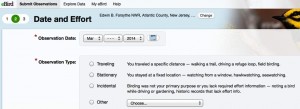
So how should record keeping be done? One way is to use a typical old-school handwritten version with field notes and drawings. This approach has a romanticism about it, but lacks some of the benefits of electronic versions. The major advantage of electronic record-keeping is that it allows searches for specific birds or locations or dates that are not possible with pen-and-paper methods. For example, I often like to search through old records for a single species, such as when and where did I see Pileated Woodpecker. Or if I’m wondering when to put out the hummingbird feeders, I can search for their typical arrival dates each year. Or when did I observe the peak migration of Broad-winged Hawks at the hawk watch? Although record keeping can be done using any electronic database, I have become hooked into using eBird (ebird.org). We will learn more about eBird in a later post, but for now we will simply note that eBird has the advantage of very easy data entry without extensive typing, the ability to include photos or comments, and the sightings become part of the larger eBird database, contributing to ‘citizen science’. As a side benefit, eBird will automatically generate updated life lists, year lists, state lists, etc. Regardless of whether you keep track of your sightings through eBird or a different electronic database, you will benefit from keeping records and the ability to search through your previous field sightings.
More advice can be found HERE in part 3 of this series, or go back to part 1.
OK, so now you’ve decided that you’d like to become a birder. Maybe a friend or someone in your family is trying to get you interested. Maybe you’ve just seen an interesting colorful bird and now want to find more. Maybe you are now retired and have time to pursue new interests. Regardless of how or why you begin with this hobby, birding can be overwhelming as a beginner and it can be intimidating to ask for help from some of the experts who are around. If this sounds familiar, I will be compiling a series of recommendations here to help you on your way. We’ll start this series with three tidbits of advice.
1. Hang in there. Probably the best place to start is by saying that if it becomes difficult in the beginning that you shouldn’t give up. Birding is a great hobby that will provide rewards for years and years and years to come. As your birding experience grows, the common birds eventually will become easy to identify, but a new group of challenge s, including rarer birds, birds in different plumages, birds in different locations, and learning bird songs will continually arise and present new challenges and new opportunities to learn. Yes, it can be tough in the beginning when it feels like you don’t know anything, but turn the difficulties into a positive. For example, as an experienced birder who has seen more than 1,200 species, it is tough for me to find new birds locally, but I am often envious when I am with new birders who are seeing a few new species every day. Enjoy the thrill and all the new things you are learning during your earliest birding adventures.
s, including rarer birds, birds in different plumages, birds in different locations, and learning bird songs will continually arise and present new challenges and new opportunities to learn. Yes, it can be tough in the beginning when it feels like you don’t know anything, but turn the difficulties into a positive. For example, as an experienced birder who has seen more than 1,200 species, it is tough for me to find new birds locally, but I am often envious when I am with new birders who are seeing a few new species every day. Enjoy the thrill and all the new things you are learning during your earliest birding adventures.
2. Get decent optics. One of the advantages of birding is that it doesn’t have to be an expensive hobby. At a simple level, the essential equipment that a beginning birder needs is a pair of binoculars and a field guide. That’s it. As your interest in the hobby grows, you will find yourself buying more equipment: a spotting scope, specialized identificati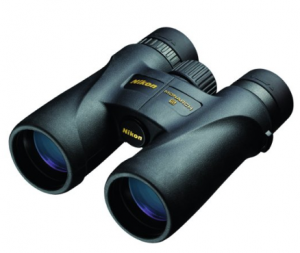 on guides, photographic equipment, birding apps, etc. But don’t worry about them now. Let’s start at the beginning: what binoculars to get? The range of cost and quality is quite broad, with top-of-the-line binoculars costing over $2,600! If you are a Wall St. executive and cost is not a concern, feel free to start there. But for the rest of us that is not a realistic starting point. On the other hand, using a clunky old pair of hand-me-down binoculars that belonged to your grandparents or buying the cheapest binoculars on the market now will only result in frustration and difficulty in finding birds. Fortunately, excellent binoculars can be obtained for ~$250 that will last for many years. The most popular model in this range is the Nikon Monarch5 8×42 binoculars, currently available for $247. I used a pair of similar Monarchs for more than 10 years and still have them as my backup pair. Monarchs are probably the most common binoculars seen on group birding walks; the optics are terrific, they are waterproof and fogproof, can focus to within 8 feet, and Nikon provides a lifetime warranty. After you’ve been birding for 10 or more years you might want to upgrade, but as a beginner, the Nikon Monarchs or similar quality binoculars is a great place to start. The only caveat to this recommendation is that no pair of binoculars will be perfect for every person; if you wear eyeglasses or if your eyes are closer together or further apart than most people, then test them yourself before buying to ensure that they ‘feel’ right to you. It is well worth the investment to avoid the frustration caused by poor optics.
on guides, photographic equipment, birding apps, etc. But don’t worry about them now. Let’s start at the beginning: what binoculars to get? The range of cost and quality is quite broad, with top-of-the-line binoculars costing over $2,600! If you are a Wall St. executive and cost is not a concern, feel free to start there. But for the rest of us that is not a realistic starting point. On the other hand, using a clunky old pair of hand-me-down binoculars that belonged to your grandparents or buying the cheapest binoculars on the market now will only result in frustration and difficulty in finding birds. Fortunately, excellent binoculars can be obtained for ~$250 that will last for many years. The most popular model in this range is the Nikon Monarch5 8×42 binoculars, currently available for $247. I used a pair of similar Monarchs for more than 10 years and still have them as my backup pair. Monarchs are probably the most common binoculars seen on group birding walks; the optics are terrific, they are waterproof and fogproof, can focus to within 8 feet, and Nikon provides a lifetime warranty. After you’ve been birding for 10 or more years you might want to upgrade, but as a beginner, the Nikon Monarchs or similar quality binoculars is a great place to start. The only caveat to this recommendation is that no pair of binoculars will be perfect for every person; if you wear eyeglasses or if your eyes are closer together or further apart than most people, then test them yourself before buying to ensure that they ‘feel’ right to you. It is well worth the investment to avoid the frustration caused by poor optics.
3. Birding books. There is an entire industry of birding books out there, enough to keep even the most refined expert birders occupied. But which of those books is appropriate or necessary for a beginning birder? For me the best field guide for a beginner is the Peterson Field Guide to the Birds of Eastern and Central North America (or Western North America if that is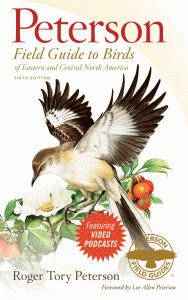 where you live). The Peterson’s Guide, which first was published in 1934 and is now in its 6th edition, was the first modern field guide for birders and to me still remains the best guide for beginners. It focuses on the more common birds, the illustrations are large, with arrows that point to the essential field marks that we should be looking for. Maps are provided in the back showing the geographic distribution of each species. The Peterson’s Guide also comes in a large-format edition and they now offer a Peterson’s “First Guide” that includes only the 180 most common birds in North America, if those are your preferences. Another excellent option is the Sibley Field Guide to Birds of Eastern North America (or Western North America if that is where you live). To me, the Sibley Guide is actually a better field guide, but it seems targeted for more advanced birders. Like the Peterson’s Guide, Sibley also has wonderful illustrations with arrows to point out the essential field marks. There are more illustrations in Sibley, including juvenile and female plumages, and birds in flight, but by necessity the illustrations are smaller than in Peterson. Sibley also includes more rarities that can appear in your area, but since those birds are unlikely to found by beginners, they can be a distraction. One advantage to Sibley is that the range maps are placed alongside the illustration, not in the back of the book, making it easier to know if that bird is likely to be seen in your area. Maybe it is just a matter of taste; these are both excellent and influential field guides, but I think Peterson’s is better for beginners, while Sibley is better for advanced birders. Whichever book you buy, don’t leave it in your car or at home for future reference, but instead bring it with you into the field and use it thoroughly, on the spot. When you find a new bird and read the accompanying commentary immediately, you will learn more, because the guide will point out secondary identification points to look for that you might have missed, occasionally behaviors will be described, potentially confusing species might be mentioned, or the illustrations might help you to find females or immature birds in the area. If you only look that information up after you get home or to your car, it will be too late.
where you live). The Peterson’s Guide, which first was published in 1934 and is now in its 6th edition, was the first modern field guide for birders and to me still remains the best guide for beginners. It focuses on the more common birds, the illustrations are large, with arrows that point to the essential field marks that we should be looking for. Maps are provided in the back showing the geographic distribution of each species. The Peterson’s Guide also comes in a large-format edition and they now offer a Peterson’s “First Guide” that includes only the 180 most common birds in North America, if those are your preferences. Another excellent option is the Sibley Field Guide to Birds of Eastern North America (or Western North America if that is where you live). To me, the Sibley Guide is actually a better field guide, but it seems targeted for more advanced birders. Like the Peterson’s Guide, Sibley also has wonderful illustrations with arrows to point out the essential field marks. There are more illustrations in Sibley, including juvenile and female plumages, and birds in flight, but by necessity the illustrations are smaller than in Peterson. Sibley also includes more rarities that can appear in your area, but since those birds are unlikely to found by beginners, they can be a distraction. One advantage to Sibley is that the range maps are placed alongside the illustration, not in the back of the book, making it easier to know if that bird is likely to be seen in your area. Maybe it is just a matter of taste; these are both excellent and influential field guides, but I think Peterson’s is better for beginners, while Sibley is better for advanced birders. Whichever book you buy, don’t leave it in your car or at home for future reference, but instead bring it with you into the field and use it thoroughly, on the spot. When you find a new bird and read the accompanying commentary immediately, you will learn more, because the guide will point out secondary identification points to look for that you might have missed, occasionally behaviors will be described, potentially confusing species might be mentioned, or the illustrations might help you to find females or immature birds in the area. If you only look that information up after you get home or to your car, it will be too late.
More advice can be found HERE in part 2 of this series.
